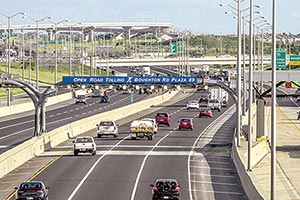Truckers Face Third Double-Digit Toll Hike on Illinois Tollway System in Three Years

This story appears in the Oct. 31 print edition of Transport Topics.
Truckers on the Illinois Tollway will be dealing with their third double-digit increase in three years come January. The 10% rise in 2017 follows a similar one in 2016 and a 40% hike in 2015.
“We’re not happy about paying higher rates for tolls, but we’re going to do whatever we have to do to safely deliver the goods that consumers want,” said Matt Hart, executive director of the Illinois Trucking Association. “The Illinois Tollway provides us with a safe, efficient mode of transporting goods, particularly in the Chicago metropolitan area where there’s a lot of congestion. Then it becomes a question of whether avoiding that congestion is worth the price of getting on the Tollway.”
That’s a question that Kevin Lhotak’s fleet of owner-operators faces every day.
“A lot of customers aren’t going to reimburse us for the tolls because they don’t have that situation in most of the states around us,” said Lhotak, president of Reliable Transportation Specialists in Chicago. “It becomes a safety issue if my drivers start going on secondary roads to avoid the tolls.”
Lhotak said a trucker driving from Chicago to Rockford, Illinois, can save an hour and 15 minutes by taking the Tollway but at a cost of nearly $30. Even when rates are cut by an average of 25% between 10 p.m. and 6 a.m. in hopes of luring trucks to use the 292-mile Tollway system during those off-peak hours, Lhotak said alternative routes are attractive because they’re free and mostly uncrowded.
“If you have a competing road that drivers realize that, depending on the time of the day, they can use an efficient alternate, they’re going to,” Lhotak said. “This is a pennies industry after our costs. We’re not counting hundred dollar bills.”
Tollway spokesman Dan Rozek said the phased-in rate hikes were approved in 2008 and delayed until 2015 “after extensive discussions with the trucking industry to address their interests in enhancing on-time delivery and easing roadway congestion.”
The 2015-2017 increases were the first on trucks since they had about tripled in 2005. Rates for passenger cars doubled that year but have risen only once since, which irks the trucking industry. According to Rozek, trucks account for about 12% of Tollway traffic but produce about 40% of its revenues.
“We don’t mind paying to use the Tollway as long as it’s affordable and safe and our rates are equitable with those of the other users,” Hart said. “The other concern we have is that, beginning in 2018, tolls will go up every year on the trucking industry, according to the Urban Consumer Price Index, which has been about 2.6% over the last several decades.”
Lhotak said while truckers have been surviving the larger hikes, “At a certain point, there’s going to be a breaking point. You’d think that a 40% increase would be that point, but when a driver looks back and says, ‘I’m paying 100% more than I was paying eight years ago,’ they’re going to have a problem with it.”
The three-year rate hikes are paying for some of the Tollway’s 15-year, $12 billion capital program that began in 2011 and includes rebuilding and widening the Jane Addams Memorial Tollway (Interstate 90) between Rockford and Chicago, constructing a new interchange to connect the Tri-State Tollway (I-294) to I-57, rebuilding 22 miles of the Central Tri-State Tollway and building the new, all-electronic Illinois Route 390 Tollway and the I-490 Tollway as part of the Elgin O’Hare Western Access Project.

